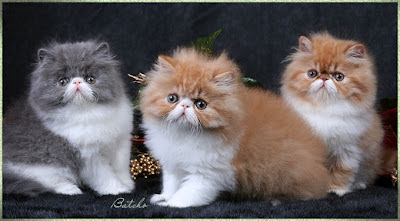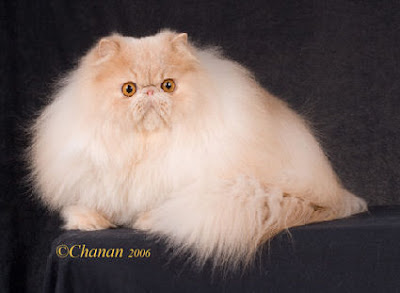An 8-year-old intact male Persian cat weighing 2.8 kg was referred to the authors’ veterinary medical teaching hospital for a second opinion and evaluation. Ten weeks before admission, the cat had been treated for lower urinary tract disease by catheterisation and flushing of the bladder, and was fed with a urine-acidifying commercial diet. Three weeks before admission, the cat was examined again by the referring veterinarian for symptoms of upper respiratory tract disease (cough, sneezing and nasal discharge). It was treated with amoxicillin trihydrate (Amoxan; Animedica, for 2 days, im), followed by enrofloxacin (Baytril, Bayer, 15 mg, q 24 h, for 5 days, sc) and eventually doxycycline (Ronaxan; Rhone-Merieux, 50 mg, q 24 h, for 10 days, orally), but the symptoms persisted along with polydipsia, polyuria and constipation, which was apparent for the last 3 days.
On admission, the cat was dehydrated and thin. It had lost almost 2 kg of its body weight over the preceding 2 months, and dehydration was estimated at 7%. The rectal temperature, pulse and respiratory rates were 39.1°C, 300 beats/min and 40 breaths/min, respectively. The mucous membranes were pale and the coat was dull and easily epilated. Routine laboratory evaluation at admission (day 1 of hospitalisation) revealed normocytic, normochromic anaemia (PCV 21.9%, normal range: 24–45%), azotaemia (BUN 60 mg/dl, normal range: 13–39 mg/dl; creatinine 2.8 mg/dl, normal range: 1.2–1.9 mg/ dl), hypoglycaemia (70 mg/dl, normal range 80–141 mg/dl) and hyperphosphataemia (12 mg/dl, normal range: 2.2–6.3 mg/dl).
Urinalysis of a specimen obtained by cystocentesis included isosthenuria (specific gravity 1·012), aciduria (pH 6), pyuria (leukocytes >100/HPF), yeast buds and hyphae. The hyphae consisted
of numerous dichotomous branching, hyalinlike, septate hyphae, that were 2–5 m wide and
oriented in the same direction. These features are characteristic of Aspergillus species (Emmons et al 1964, Petersen 1988). Fungal cystitis was diagnosed. Low urine specific gravity with concurrent polydipsia, polyuria and dehydration were indicative of renal dysfunction. Aspergillus species was isolated in pure culture from a urine sample obtained by cystocentesis on day 2 of hospitalisation.
The culture was made in a Sabourauds dextrose agar plate, which was incubated at 28°C for up to 5 days. Green/brown red colour colonies were noticed. An impression smear stained with Giemsa stain revealed the typical Aspergillus species morphology. Findings from thoracic and abdominal radiography, as well as ultrasound examination of the kidneys, revealed no evidence of visceral or pulmonary involvement. A test for feline leukaemia and feline immunodeficiency virus infection (Combo test, IDEXX) was negative. Cytologic examination of the nasal discharge was negative for fungi, as was the blood culture. Serum examined for antibodies against Aspergillus species was positive for A nidulans and thus the A nidulans cystitis and possibly pyelonephritis were diagnosed. For the detection of antibodies against A nidulans, the gel diffusion precipitation test (GDPT) was used (Heska UK Limited, Devon). For this purpose, antigens of A flavus, A niger, A nidulans and A terrens were reconstituted with 1 ml deionised water. The antigens were stored at 4°C before and after reconstitution. For gel preparation, sodium chloride, phenol, 1N sodium hydroxide, 1 N HCl and OXOID agar no. 1 were used. When soluble antigens and homologous antibodies are placed in adjacent wells, they cut into a suitable diffusion media and they will diffuse towards one another and produce a visible precipitation line.
On day 4, fluconazole (Fungistatin; Pfizer, 7.5 mg/kg, q 12 h, orally) was administered. A
CBC count revealed a normocytic, normochromic non-regenerative anaemia (PCV 19%, Hb 6.3 g/dl, reticulocyte count 0.27), moderate leucocytosis (21,800/l) and neutrophilia (14,388/l) with a regenerative left shift (bands 3988/l). Laboratory results indicated azotaemia (BUN 56 mg/dl, creatinine 2.6 mg/dl) and hyperphosphataemia (11 mg/dl). On day 5, the cat was released. The owner was instructed to administer fluconazole (7.5 mg/kg, q 12 h, orally) and aluminum hydroxide (130 mg, q 12 h, orally) until re-examination. Enrofloxacin (25 mg, q 12 h, orally) was also prescribed for 15 days and the cat was placed under a diet for renal failure.
The Persian cat was reexamined 6 weeks after discharge. It weighed 3.3 kg and its PCV was 22%. Results of serum BUN, creatinine and phosphorus were within normal limits. The urinalysis of a specimen obtained with cystocentesis revealed that the urine specific gravity was 1·024. The urine culture for fungi was negative. A third urine culture for bacteria and fungi was performed 15 days later and it was also negative. The fluconazole was discontinued 15 days after the third urine culture. The animal’s body weight returned to 5 kg and the owner reported that the cat was healthy 16 months after discharge without any similar problem.

















0 comments:
Post a Comment